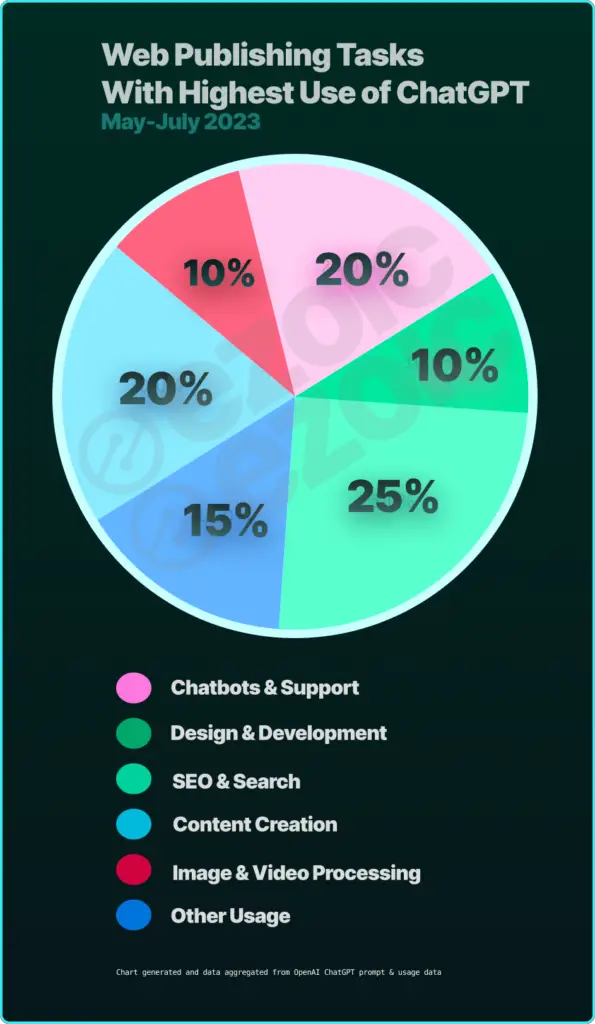Since the start of 2023, AI has been the center of discussion and disruption across many industries, but none have been so uniquely and directly impacted as digital content creators. AI’s influence in web publishing, content creation, and web development has been profound and multifaceted. The 3 charts below provide an unprecedented look at just how this evolution is occurring.
How are websites using ChatGPT?

This pie chart offers a visual representation of ChatGPT usage distribution across disciplines typical to website owners and web publishing. These categories, highlight areas such as Content Creation, SEO, and other common skilled work that is a major part of typical website building and development.
Below are definitions of the concepts in the charts; as a few of the categories are closely related.
1. Content Creation: No longer limited to human authors, today’s content landscape sees AI-powered tools auto-generating news summaries, financial reports, and basic articles. While this doesn’t replace the need for human touch, it certainly augments our capacity to produce vast amounts of data-driven content swiftly.
2. Personalization: Remember the last time a website seemed to ‘know’ your preferences? AI-driven algorithms analyze user behavior and curate content tailored for individual users, enhancing user experience and engagement.
3. Search and SEO: With algorithms like BERT, search engines have grown adept at grasping user intent. This deeper understanding translates to more relevant search results and necessitates a shift in SEO strategies.
4. Design and Development: Imagine describing a design, and AI generates it for you! Tools like GPT-3 are making this a reality, turning natural language queries into code snippets and design elements.
5. Chatbots and Customer Support: Many websites now feature AI-driven chatbots, providing real-time customer support and reducing the need for human intervention.
6. Image and Video Processing: From recognizing faces in photos to analyzing video content, AI has revolutionized image and video processing.
Is AI The Right Tool For The Job?

In the chart above “job roles impacted…” refers to the number of tasks and associated AI tools available that can perform or automate the typical functions of that role; as commonly defined.
This data underscores a crucial aspect of AI’s influence – the changing job market and how many of these jobs will be done from here on out. While a role may have a lot of AI tools available, it doesn’t mean that a human still isn’t required. In fact, these tools often give humans a unique advantage in doing these jobs better than ever before. As AI automates certain tasks, the demand for specific roles shifts, prompting a need for upskilling and adaptation among professionals.
While disruptions caused by AI are not exclusive to digital publishing, many of the tasks AI tools have streamlined are tasks often performed inside publishing businesses.
The glass-half-full here for websites is that AI may disproportionately offer value for their businesses before it does for other industries.
AI Tools: From Niche Usage To Major Industry

The global projected growth of AI tools and software highlights the reliance many industries are expected to have in the near future on AI technologies. As AI continues to advance, regions around the world are investing heavily in this technology, recognizing its potential to drive growth and innovation.
AI Can Provide More Good Than Bad For Publishers
AI’s footprint in the world of web publishing and development is undeniable. While it presents challenges, it also opens doors to unprecedented possibilities. As we continue to harness AI’s potential, it’s imperative to remain adaptable, invest in continuous learning, and view AI as a tool that complements human creativity and innovation.


